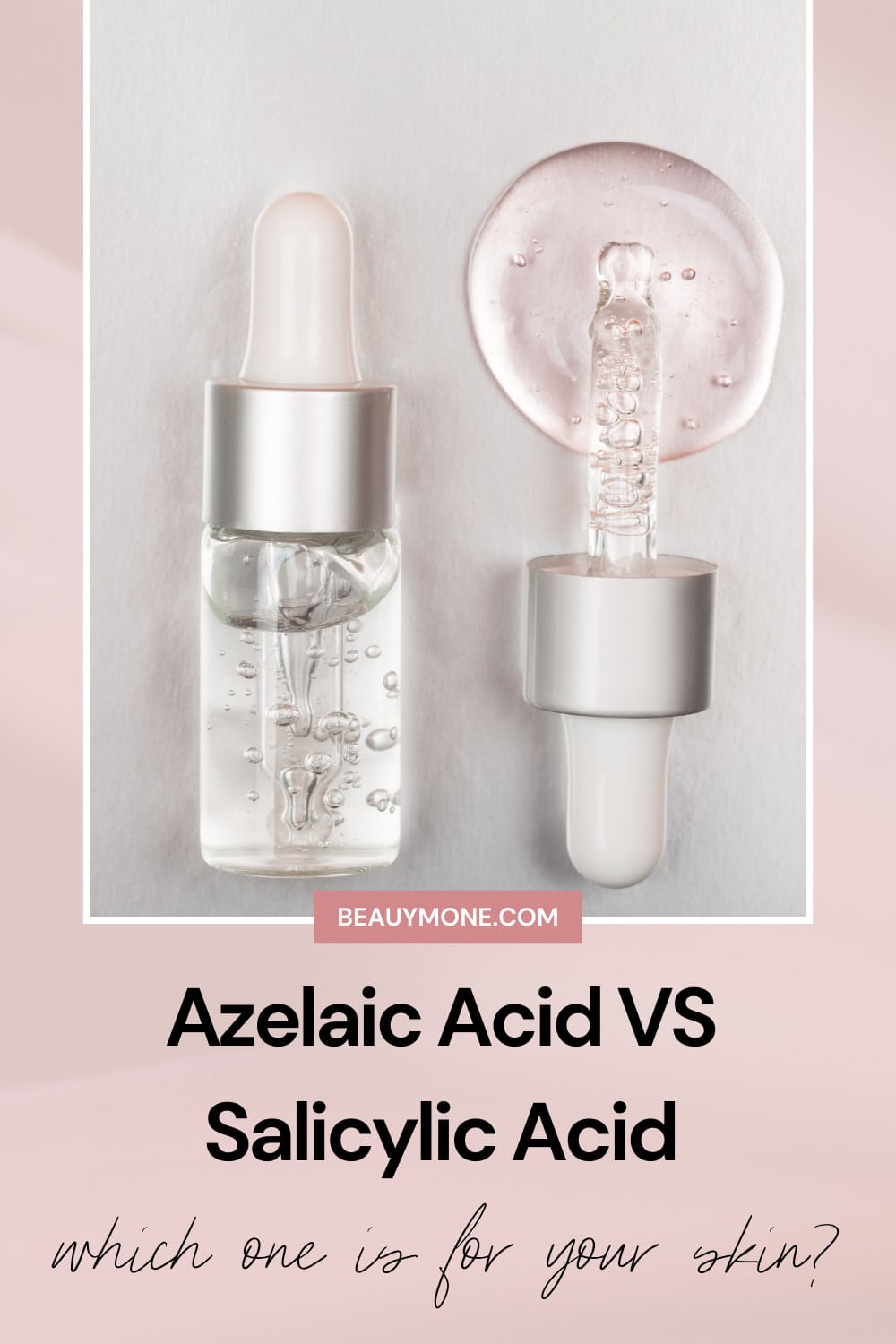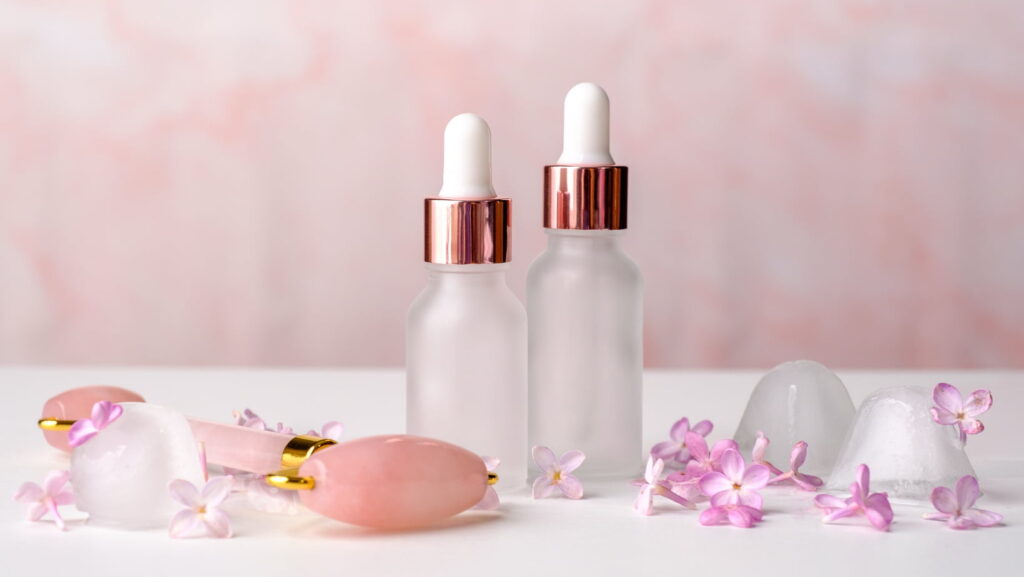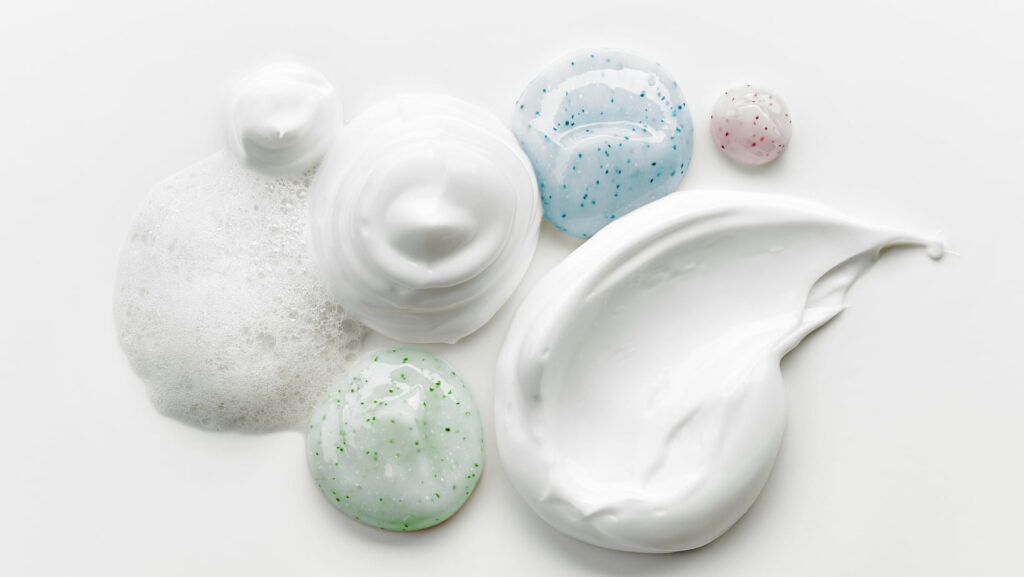
As someone who’s always looking for ways to improve my skin, I understand the challenge of finding suitable skincare products.
With countless options on the market, it can be overwhelming to decide which ingredients will work best for our individual needs.
Today, we will focus on Azelaic Acid VS Salicylic Acid – two powerful acids with unique benefits for the skin. We’ll dive into their differences and determine which one might be best suited for you.
While they’re commonly used to tackle acne, these acids aren’t just a one-trick pony. Azelaic and Salicylic Acid are widely praised for their potential to address various skin concerns.
They can also help with issues like redness, uneven skin tone, and clogged pores. But it’s essential to understand their unique properties and how they interact with our skin before deciding on one or the other.
To pick the winner of the Azelaic Acid VS Salicylic Acid debate, you first need to know some things about both. We’ll begin by exploring the properties of Azelaic Acid, its strengths, and potential drawbacks, followed by an in-depth look at Salicylic Acid.
By the end of this discussion, you’ll know exactly which one is the best option for your skin. So, let’s get started on our journey to achieving better, healthier skin together!
Understanding Azelaic Acid
Azelaic acid often appears in several skincare discussions about treating various skin conditions. Despite its popularity, understanding the benefits and drawbacks of this ingredient can be confusing.
In this section, I’ll serve you all the hot info on what azelaic acid truly is and how it can become an addition to your skincare routine.
Azelaic acid is a naturally occurring acid found in grains such as wheat, barley, and rye. It’s also produced by the yeast that lives on human skin.
In skincare products, azelaic acid can be found in various formulations, including creams, gels, and foams. Although it is a natural ingredient, in these products, we find it in its synthetic form.
It’s famous for its anti-inflammatory, antioxidant, antimicrobial, and brightening properties, making it a popular choice for those dealing with conditions like acne, rosacea, and hyperpigmentation.
Quick Summary Of The Benefits Of Azelaic Acid In Skincare:
- Azelaic acid reduces inflammation, which may help with redness and irritation associated with acne and rosacea.
- It kills acne-causing bacteria on the skin’s surface, reducing the likelihood of breakouts.
- It removes dead skin cells and unclogs pores, thanks to its exfoliating properties.
- It lightens dark spots and evens out skin tone, particularly for those suffering from post-inflammatory hyperpigmentation.
Which Skin Types Go Well With Azelaic Acid?
Azelaic acid is praised for its skin-clarifying abilities and gentle nature. Most individuals can use it without irritation, even those with sensitive skin. However, it’s still essential to patch-test the product before incorporating it into your routine.
Pro tip: To do this, apply a small amount of the product on an inconspicuous area of your skin to check for any adverse reactions.
Things To Be Mindful Of When Choosing Azelaic Acid
One possible downside of azelaic acid can be its potential to cause dryness and irritation, notably when used in higher concentrations or in combination with other active ingredients.
Thus, it’s essential to start slow and low with any new azelaic acid product – meaning, begin by using lower concentrations and gradually working your way up, allowing your skin to become accustomed to the acid.
While azelaic acid offers a multitude of benefits, it’s essential to remember that it might not be the best choice for every skin type or concern.

Exploring Salicylic Acid
Salicylic acid is a beta hydroxy acid (BHA) generally derived from willow bark. Its property of reducing pain and inflammation has been hailed for centuries.
To refresh your beauty guru knowledge, BHAs, like salicylic acid, are oil soluble. It is, therefore, capable of penetrating deep into pores to dissolve excess oil, dead skin cells, and debris.
Salicylic acid is primarily famous for targeting acne. However, in addition to its powerful acne-fighting and pore-clearing properties, there are other benefits to salicylic acid that make it a favorite of skincare enthusiasts.
Studies suggest that salicylic acid boasts anti-inflammatory, antimicrobial, and deeply exfoliating properties, among others.
Quick Glance At The Main Benefits Of Salicylic Acid
- Salicylic acid has keratolytic properties, helping to exfoliate and unclog pores.
- It has anti-inflammatory properties, reducing redness and swelling.
- It has antimicrobial properties, inhibiting the growth of bacteria.
- It can regulate sebum production, reducing oiliness and preventing acne.
- It can enhance skin penetration of other ingredients, making them more effective.
Which Skin Types Complement Salicylic Acid
While salicylic acid can be effective for many skin types, those with dry skin may need to be cautious. Salicylic acid can be drying, as it works to exfoliate the skin and regulate sebum production.
However, this does not necessarily mean that those with dry skin cannot use salicylic acid. Studies have shown that when used in lower concentrations and with appropriate moisturizing, salicylic acid can be effective in treating acne in those with dry skin.
Things To Know Before Grabbing Salicylic Acid
It is crucial to start with a lower concentration and gradually increase use to avoid excessive dryness or irritation.
It would be best if you always considered the concentration of salicylic acid in a product. It usually ranges from 0.5% to 2%, with higher percentages being more potent.
While higher concentrations can combat stubborn acne, they’re also more likely to cause skin irritation, so it’s essential to choose wisely based on your skin’s needs.
Additionally, using a hydrating moisturizer after applying salicylic acid can help to prevent dryness and flakiness.
Benefits of Azelaic Acid for Your Skin
If you are to choose the suitable ingredient -Azelaic Acid VS Salicylic Acid- for your individual needs, it’s crucial to understand their unique benefits.
Azelaic acid is a powerful yet gentle ingredient that offers a variety of advantages for your skin. We have seen just a summary of what it can do.
In this section, I’ll analyze the critical benefits of azelaic acid based on several comprehensive studies (like this one and this one). You can then make an informed decision on whether this ingredient is suitable for your skin.
Anti-Inflammatory
Azelaic acid is well-known for its anti-inflammatory properties. It helps reduce inflammation and redness associated with various skin conditions, such as acne and rosacea. By doing so, it can significantly improve the appearance and comfort of your skin.
Antimicrobial
Azelaic acid also offers antimicrobial benefits. It’s been found to effectively target acne-causing bacteria (Propionibacterium acnes) on your skin, helping prevent blemishes from forming.
Melanogenesis Inhibitor
Another fantastic benefit of azelaic acid is its skin-brightening capabilities. It works to even out skin tone by reducing the appearance of hyperpigmentation, dark spots, and melasma. This is achieved through the inhibition of melanin production in the skin.
Keratolytic
Azelaic acid has been shown to have keratolytic properties, meaning it can help to exfoliate the skin and improve its texture. It is, therefore, effective in reducing the appearance of fine lines and wrinkles.
Suitable For Sensitive Skin
For those with sensitive skin or conditions such as rosacea, azelaic acid can be a game-changer. Its gentle nature makes it suitable for all skin types, even those that may be prone to irritation from other acids.
To sum up: Azelaic acid can do wonders for conditions that include redness and inflammation, such as rosacea. It is gentle for sensitive skin and also boasts excellent skin-brightening properties.

Benefits of Salicylic Acid For Your Skin
As I’ve delved into the world of skincare, I’ve come to understand the variety of benefits that salicylic acid has to offer.
This versatile BHA provides several advantages for various skin types and concerns. Salicylic acid is a beta hydroxy acid that is well-known for its benefits for the skin, particularly in fighting acne and removing dead skin cells[1].
Here are some key benefits of using salicylic acid in your skincare routine:
Anti-Inflammatory
Anti-inflammatory properties are one of this acid’s key components. Salicylic acid has a similar chemical structure to aspirin, meaning it topically works to soothe inflammation and redness.
Deep Cleansing
Due to its oil-solubility and ability to penetrate pores, salicylic acid effectively dissolves excess sebum, and deep-cleans clogged pores. This attribute makes it an excellent choice for those with oily or acne-prone skin.
Deep Exfoliation
As a chemical exfoliant, salicylic acid gently removes dead skin cells, promoting a smoother and brighter complexion.
Its keratolytic properties break down the bonds between skin cells, promoting a gentle and gradual shedding of the uppermost layer of the skin, revealing a smoother and healthier complexion.
Blackhead and Whitehead Reduction
Salicylic acid effectively breaks down the debris that forms blackheads and whiteheads, allowing them to be more easily removed, making it a fantastic addition to your skincare routine if you struggle with these common skin issues.
Improvement Of Skin Texture and Tone
By promoting cell turnover and exfoliating the surface layer of the skin, salicylic acid can help reduce the appearance of dark spots, uneven skin tone, and dullness.
To sum up: Salicylic acid is a more intrusive ingredient that deeply exfoliates the skin and clogs out pores.
These characteristics, combined with its anti-inflammatory and antibacterial properties, make it a hailed remedy for acne and sebum regulation. Its keratolytic properties have also been shown to reduce signs of photoaging.
To give you a clear idea of how salicylic acid benefits various skin concerns, let’s examine the following table:
| Skin Concern | Benefits of Salicylic Acid |
| Oily skin | Dissolves excess sebum and deep-cleans pores |
| Acne-prone skin | Targets acne-causing bacteria and prevents future breakouts |
| Blackheads and whiteheads | Breaks down and removes debris |
| Uneven skin tone | Promotes cell turnover and exfoliates the surface layer |
Comparing Azelaic Acid VS Salicylic Acid
When it comes to choosing the right acid for your skin, it’s essential to consider the unique properties and benefits of Azelaic Acid and Salicylic Acid.
To shed some light on the differences and similarities between these two popular skincare ingredients, I’ve created a table summarizing their essential characteristics and benefits:
| Azelaic Acid | Salicylic Acid | |
| Source | Grains | Willow Bark |
| Type | Dicarboxylic Acid | Beta Hydroxy Acid (BHA) |
| Benefits | – Reduces redness and inflammation – Boasts skin-brightening effects – Helps prevent breakouts – Great for rosacea and melasma | – Exfoliates and unclogs pores – Reduces sebum production – Soothes inflammation – Great for acne regulation and photoaging |
Making the Right Choice for Your Skin
Choosing between azelaic acid and salicylic acid is a puzzle. I’m here to help you decide which one might work best for your skin.
We’ll consider a few factors, such as your skin type, your specific skincare concerns, and any potential sensitivities.
First, let’s take a look at their key characteristics and effects on the skin:
| Azelaic Acid | Salicylic Acid |
| Works well for acne-prone or rosacea-prone skin. | Best suited for acne-prone and oily skin. |
| Reduces inflammation and redness. | Exfoliates and removes dead skin cells. |
| Brightens skin tone and minimizes hyperpigmentation. | Penetrates more profoundly into the pores to prevent acne. |
| Suitable for sensitive skin. | It could cause dryness, irritation, or sensitivity in some cases. |
If you’re dealing with inflammatory acne, rosacea, or hyperpigmentation, Azelaic Acid may be your best bet. Its gentle exfoliating properties make it suitable for sensitive skin types as well.
On the other hand, if you have oily, acne-prone skin with clogged pores and blackheads, Salicylic Acid could be a better option. It’s able to penetrate deeper into the skin due to its oil solubility, making it more effective at clearing congestion and reducing oil production.
For those who have sensitive skin, azelaic acid emerges as a winner. It’s less likely to irritate while still delivering noticeable results. And when it comes to skin brightening, azelaic acid is a better option due to its melanin-inhibiting properties.

Azelaic Acid VS Salicylic Acid: A Conclusion
Both azelaic acid and salicylic acid come with impressive benefits, and the right one for you will depend on your unique skin type, concerns, and goals.
Whichever one you use, it is essential to keep a few things in mind for the better health of your skin.
When introducing any new skincare ingredient into your routine, it’s always important to patch test and start with a lower concentration to minimize potential irritation.
Remember to follow up with a good moisturizer and sunscreen, as both azelaic acid and salicylic acid can increase skin sensitivity to sunlight.
It’s important to discuss any new skincare ingredients with a dermatologist, especially if you have specific skin concerns or use other treatments.
With this information in hand, I hope you’ll make a more informed and beneficial choice for your skincare journey.
Frequently Asked Questions

helloo i have black heads and closed comedones and barely any redness but i see so many people say salicylic acid will cause purging and that it’s an overrated ingredient i used it once 3 years ago (i’m 19) and it helped a lot with my forehead bumps but now my skin is a bit more sensitive so i’m scared since anti inflammatory acne isn’t something i struggle with to use azelaic acid it would be really helpful if u could give an opinion
Hey there! Based on what you’re saying, I don’t think salicylic acid and azelaic acid is the best combination for you since you have a bit more sensitive skin now. As you’ve seen some results while using salicylic acid in the past, it might be a good idea to try it again but in combination with a product that contains hyaluronic acid. To avoid a strong reaction (such as purging) of the salicylic acid, I would suggest trying a product that contains a low concentration. A product that I personally really love is the CeraVe SA Smoothing Cleanser with Salicylic Acid. It’s a very gentle product but still fights black heads and closed comedones! It even contains hyaluronic acid and it is fragrance-free so it won’t cause any sensitivity. Hope this helps! 🙂